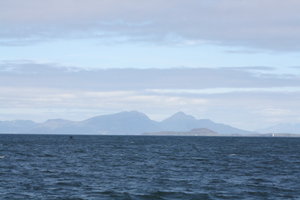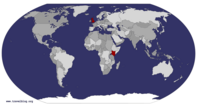Advertisement
Published: August 16th 2011

 Out On The Water
Out On The Water
The surrounding islands of Skye and Eigg as seen from the boat.The boat rode through the waves, swaying from side to side as the wind whipped passed my face. I held on to the rail around the deck tightly as I searched the surrounding waters with my binoculars, hoping for a glimpse of the animal I was looking for. But there was nothing except a few little sailing boats bobbing in the sea.
I was on a seven-hour whale-watching trip around the waters of the Isle of Mull on the west coast of Scotland, a place renowned for it’s marine wildlife. Accompanying me on this voyage was my Dad, a pair of newlyweds, and a middle-aged couple and a few others. We were being guided by a hardy crew from Sea life Surveys a company that has traversed the waters of west Scotland since 1982 and has played an active part in the research and conservation of cetaceans (Dolphins, Whales and Porpoises.)
We headed out through the sound of Mull between the island of the same name and mainland Scotland. The sea gleamed in the little pockets of sun that broke through the clouds above us. I continued to survey the surrounding area for any sign of wildlife trying to

 The porpoise
The porpoise
A quick glimpse of a porpoise before it disappeared under the waterleave no spot of water unchecked. Searching for whales and Dolphins with so many waves was going to be tricky; sometimes the only sign of these animals above the water’s surface is a little round bump or a quick glimpse of a dorsal fin.
Just as we left the sheltered waters of the sound and ventured out to the open sea, both the sun and the wind intensified. Wonderful. However my mind was taken off the current conditions as we soon spotted a vast array of sea birds including Manx shearwaters racing across the sea and guillemots, accompanied by their fluffy black and white chicks, bobbing in the waves. To the side of the boat I could see the jagged peaks of the neighbouring islands of Skye and Eigg and way out in the distance the Isle of Coll rose above the horizon, our lunchtime stop where we hoped to see porpoises and hopefully Minke whales.
The smallest species of baleen whale in the world, an adult Minke whale reaches a total length of around 10 metres, which appears tiny when compared to the gigantic Blue whale, which can reach 30 metres in length. In fact the Minke

 The Beach
The Beach
The white sandy beach in the Cairns of Collwhale was once considered too small for whalers to hunt and as a result it is now one of the most common whale species in the world. However in recent years whalers have turned to hunting the species due to its abundance and countries like Iceland, Norway and Japan which continue the trade, catch around 2300 Minke whales a year. Fortunately though the species remains undisturbed in the waters of the UK although that doesn’t mean spotting a Minke whale was an easy task as I was beginning to find out.
The Isle of Coll grew closer as we sliced through more waves and before long we neared the calmer waters around the northern tip of the island. Here one of the guides, Ruth explained that it was a good spot for porpoises and ever determined to spot something everyone including the newly weds, the middle-aged couple, my dad and I, all got out our binoculars. I stood waiting and hoping something would eventually appear. The whale-watching trip had already been postponed from the day before due to bad weather and unfortunately numerous cases of seasickness. I was running out of time to see a whale.
Then, I

 The Welcome Party
The Welcome Party
A group of common seals watch our arrivalturned around as I heard Ruth say “they’re some porpoises at nine o’ clock”. I rushed to the other side of the boat this time getting my camera ready. I peered over the side and sure enough with a complete lack of noise, two porpoises broke the water’s surface and their brownish grey bodies came into view. Their tiny dorsal fins poked above the surface for the smallest of moments and just after I took a few quick photos, the two porpoises disappeared back into the deep, vanishing from sight.
The common or harbour porpoise is the smallest species of cetacean and despite having depleted in number in areas like the Baltic sea due to hunting and fishing accidents, it is listed as “least concern” in terms of being endangered with extinction by the IUCN (International Union for the Conservation of Nature) due its abundance worldwide. As a result the harbour porpoise is a common sight to whale watchers as it is often found in shallow waters near uneven seabeds, which stir up sand eels, to which they have a particular predilection. Often another special sight in the waters around Mull during spring and summer are the newly born

 Head First
Head First
A common seal dives into the waterharbour porpoise calves which as I’m told by the guides Ruth and Ewan “look like little rugby balls in the water.”
With the porpoises well and truly gone we turned towards the Cairns of Coll, a collection of small islands and beaches at the north of the isle of Coll where we would stop for a lunchtime break. I peered over the side as we came into the middle of the cove and saw the water change from a deep blue colour to being as clear as glass as the sea became shallow. Passing by the rocky islands we watched as large groups of Common Seals raised their heads at our arrival. Some slid into the water for a closer look at the boat and we watched in joy as little furry faces peered out of the water at us. The boat stopped and our skipper, Richard explained we would take a small rubber dingy to the nearby beach for our lunch break. Of all the passengers on the boat, no one seemed more eager to go to the island beach than the boat’s dog Sula, who hopped on the rubber dingy with such enthusiasm, it put us all to shame. We reached the island and walked onto the beach. The white powdery sand looked more at home on a remote tropical island then on the west coast of Scotland and as I looked out to the open sea I saw the water fade from a deep azure blue to an emerald green hue as the water got shallower. One of the passengers took to celebrating our arrival on the island in a rather unusual way and in the blink of an eye had stripped down to a pair of trunks and swam out into the cove. I put my arm in the water and felt the temperature. The man was clearly insane. Or possibly very hardy. Several seals bobbed towards the man as he swam out in the distance and before long it became very hard to tell man from seal.
I sat beside my dad on the beach and tucked into a sandwich as the wind died down a little. Overhead several arctic terns, a species that breeds on the isle of Coll were soaring in the sun. I decided to explore more of the island and clambered over the rocks to the other side. Suddenly I found myself face to face with two common seals on the opposite island and slowly, I slid over the seaweed covered rocks at the edge of the beach and felt its smooth texture with my hands. The two common seals were basking in the bright afternoon sun. I crept closer trying not to disturb them. Their smooth rounded bodies glistened in the bright light and quietly I took a photo with my camera. I then moved away and left the seals to their own business.
As I walked back to the beach I heard it was time to return to the boat and saw the guides rubber dingy heading towards the shore. Just as I climbed into the dingy I was greeted with the sight of a rather soggy Sula.
“Did Sula go for a paddle then?” I asked.
“She couldn’t help it!” Ruth replied laughing.
Perhaps she wanted to try being a seal for a bit. We returned to the boat and waving goodbye to the Cairns of Coll, we headed back out to the open sea.
For the rest of the afternoon we watched from the boat as gannets zoomed through the air and were treated to the sight of more guillemot chicks, razorbills, great skuas and even puffins, but the Minke whales remained hidden throughout the entire trip. However as we headed back to the Isle of Mull I wasn’t disappointed with the day at all. I was more excited by the photos and memories from encountering seals and porpoises than what I didn’t see. It’s become a given that some people, expecting wildlife documentary like encounters of animals, will inevitably be disappointed tremendously because the weren’t able to stare into the eyes of their favourite animal, but that just isn’t how the natural world works. Animals live a world away from our life of schedules and deadlines, but perhaps that’s why I like them so much.
(And if you’re wondering if I’d recommend doing a trip with Sea Life Surveys, then the answer is 100% yes I definitely would. They’re a great company to be out on the water with providing all the information you could ever want on a Minke whale’s bad breath, and every detail to marine wildlife. Also by helping the crew spot animals like porpoises and Minke whales you are helping the company continue to research and protect these species. I hope to do another trip one day in the future.)
Advertisement
Tot: 0.151s; Tpl: 0.036s; cc: 10; qc: 49; dbt: 0.0744s; 1; m:domysql w:travelblog (10.17.0.13); sld: 1;
; mem: 1.2mb








